
Among the vines, the tractor is the focal point of the harvesting activity
On September 15, 2011, Didier and I were invited back to the Domaine Berthet-Rayne to see and photograph the Châteauneuf-du-Pape vendanges, or grape harvest. This was our third trip to the estate: In a first visit on April 21, we were given a tour of the winery and the vineyards with the then barely budding grapes. We were back on July 29; the purpose of that second visit was to see how the grapes had evolved. Now we had returned for the highlight of the winemaking year, the vendanges.
For the harvest, the Berthet-Rayne family routinely employs a group of seasonal workers. Most of these come from Spain, and we were not surprised to hear that the same workers show up year after year. When one person is unable to make the journey, the Spanish families automatically arrange a replacement. This, I think, is a tribute to the working conditions on the estate: indeed, Laure Berthet-Rayne and her husband Martial work as hard as any of the seasonal workers, and everyone seems to get along great. This year, in spite of losing part of the harvest to hailstorms, there were so many grapes that a couple of additional people had to be hired. Everybody made it easy for us by putting up with our cameras in a good-natured fashion.
Click on any image to see a larger (1500 x 1000 pixel) version!
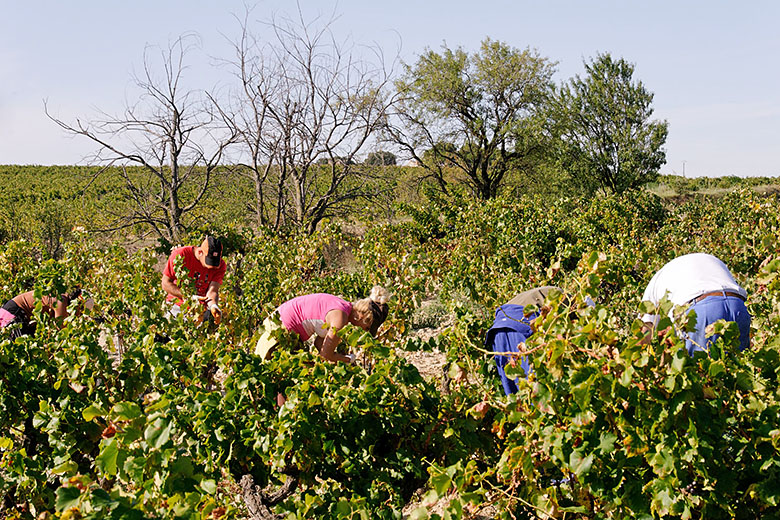
|
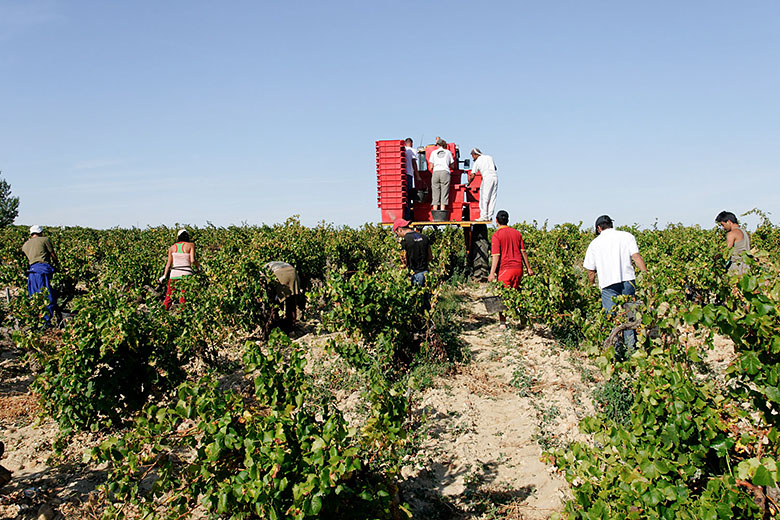
|
Grape pickers |
Following the tractor |
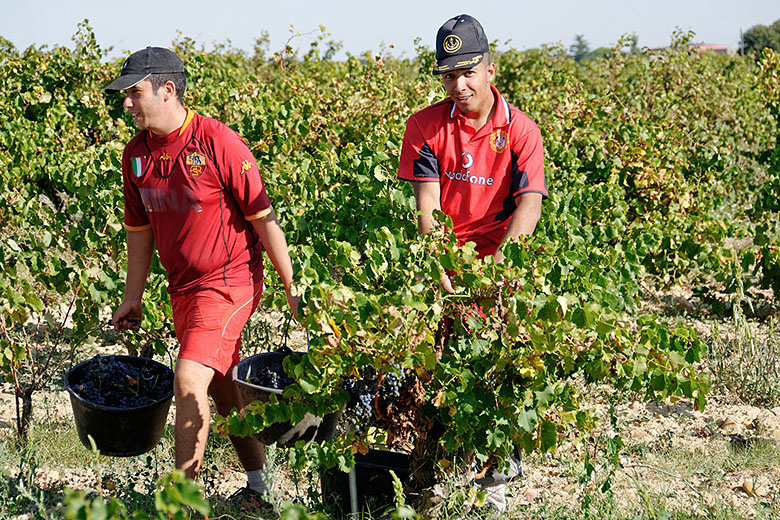
|
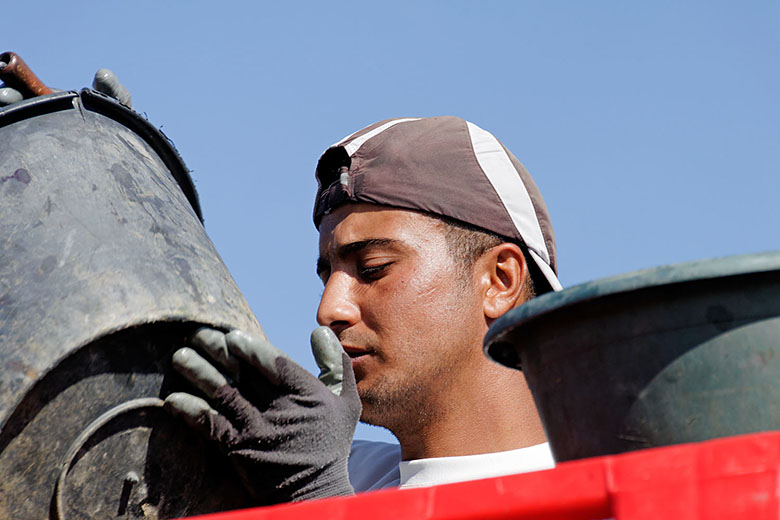
|
Full buckets are brought to the tractor... |
...where their contents are poured into plastic containers. |
The way the harvesting process works is that the tractor is standing in the vineyard, straddling one row of vines, engine off. The pickers cut off bunches of grapes from the vines behind the tractor and drop them into plastic buckets. Grape carriers pick up the full buckets and carry them to the tractor. On the tractor's rear platform, the grapes are manually sorted and placed into plastic containers: only those that are considered good enough will eventually be made into Châteauneuf-du-Pape, the estate's flagship product. Every few minutes, the tractor's engine is started and the vehicle is moved a few yards further down the vineyard. When the rear platform cannot hold any more full plastic containers, the tractor is driven to the edge of the vineyard, and the contents of the plastic containers are transferred into the harvesting bin that is parked there. The tractor then goes back to the spot where it left off and the process continues. Several harvesting bins are filled in this fashion.
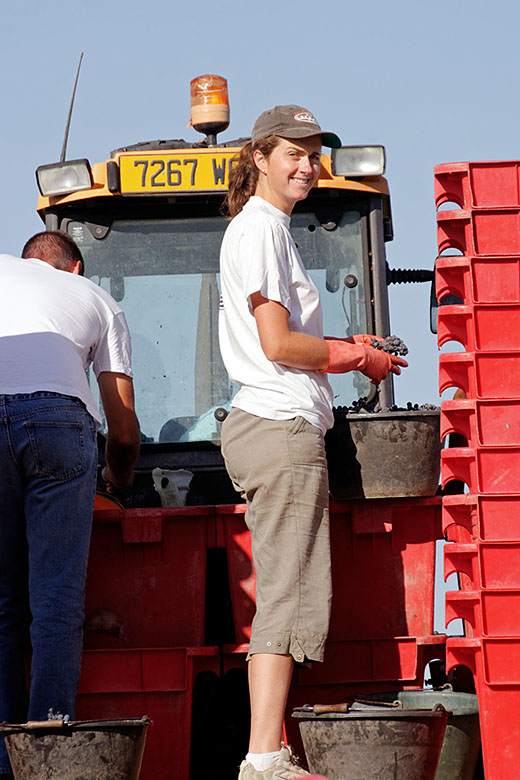
|
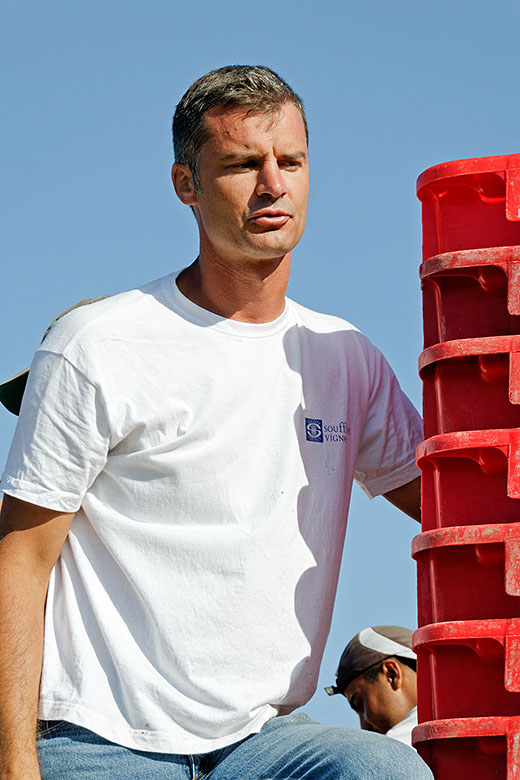
|
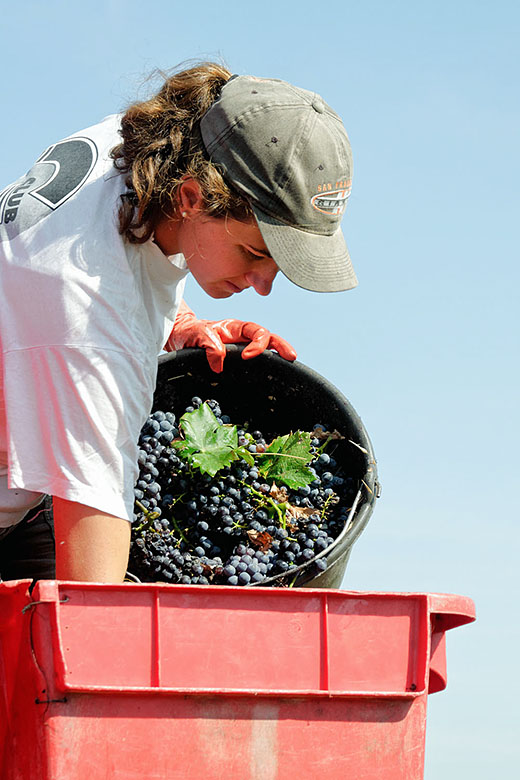
|
Laure Berthet-Rayne... |
...and husband Martial Capeau. |
Sorting grapes on the tractor |
As should be obvious to anyone watching, harvesting grapes is an extremely demanding activity. More often than not, one has to bend over the vines, the buckets get heavy as they fill up, and the task is seemingly endless: vine by vine, bucket by bucket, container by container, harvesting bin by harvesting bin, for several days on end... it does surely take quite a bit of stamina! Of course, mechanical harvesting would be a great deal easier, but on the Berthet-Rayne estate, everything is done to produce the best possible wine, and mechanical harvesting clearly affects the quality of the final product because it damages the grapes far more than picking by hand. The idea is to keep the grapes as intact as possible before they are destemmed and crushed, so harvesting by machine is out. Having had the privilege of tasting the Berthet-Rayne wines, I can only agree with the winery's philosophy.
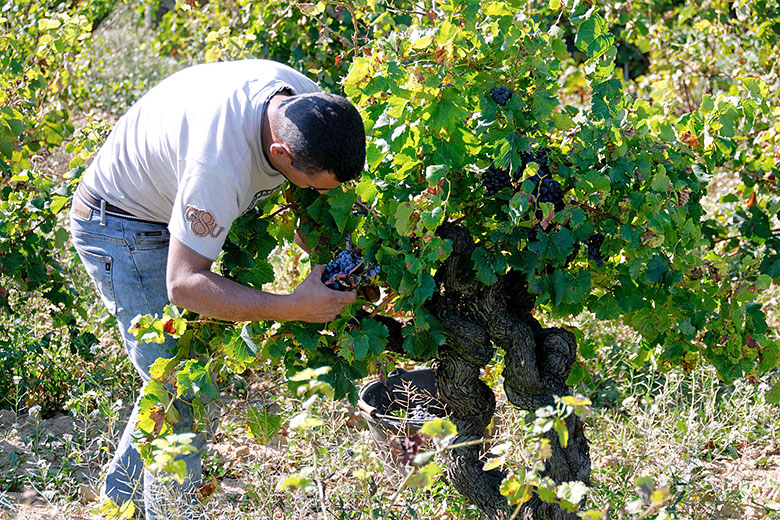
|

|
Grape picker |
Grape picker |
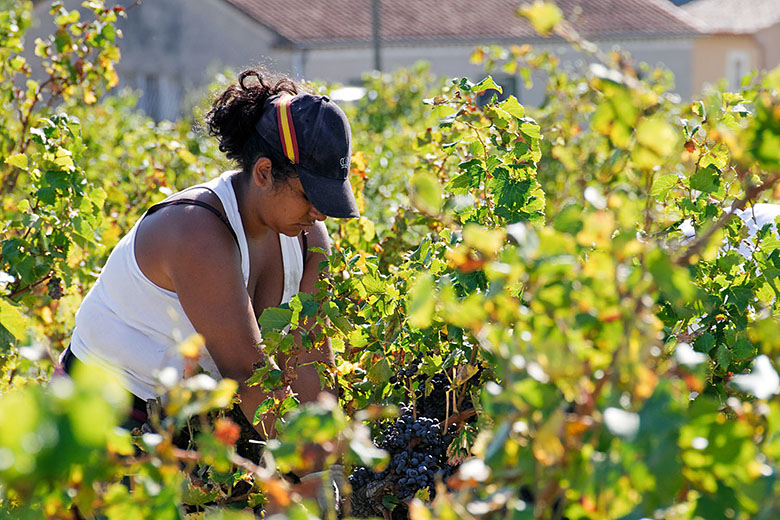
|
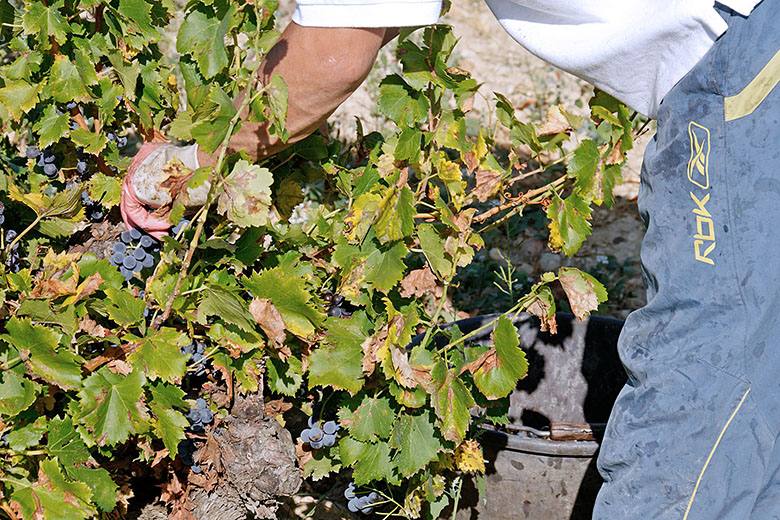
|
Grape picker |
Grape picker |
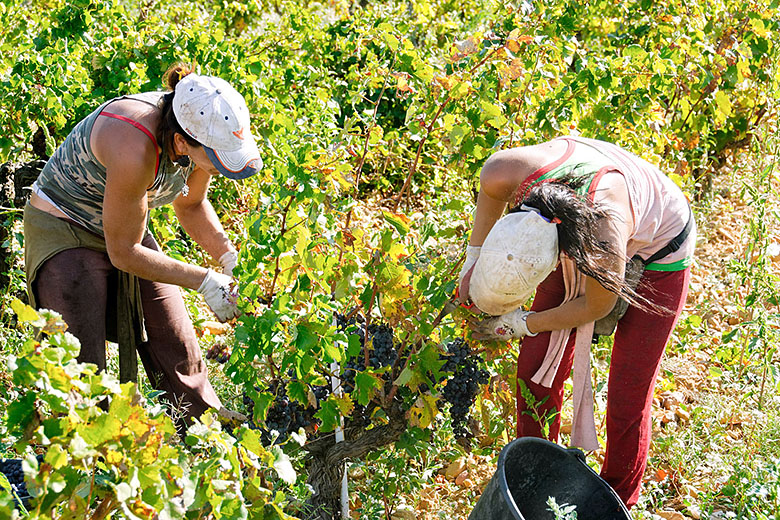
|

|
Grape pickers |
Grape pickers |
As an aside, certain pickers were extremely conscious of the camera and systematically looked the other way when they sensed a lens aimed in their general direction. Others were the exact opposite and practically begged to have their picture taken time and time again. This is especially true of the ladies; the men, one enthusiastic exception aside, didn't seem to care one way or the other whether their picture was being taken. All in all, I took over eighty photos of the pickers and made them available to them on a separate page. They were truly a fine group of people.
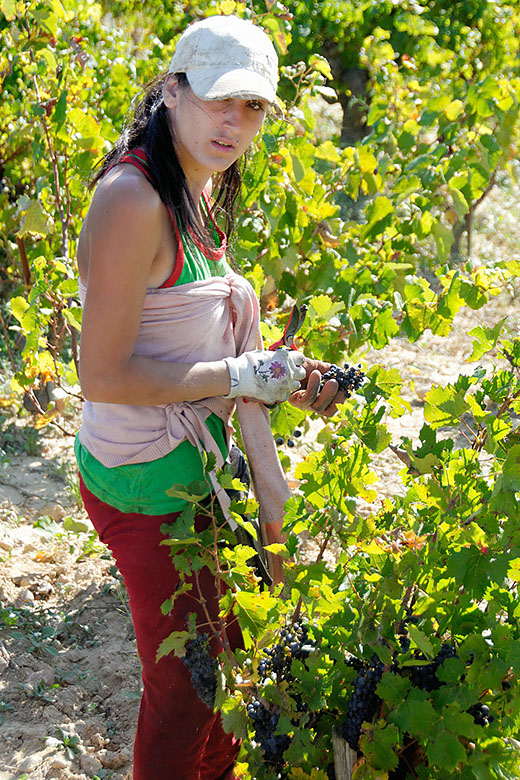
|
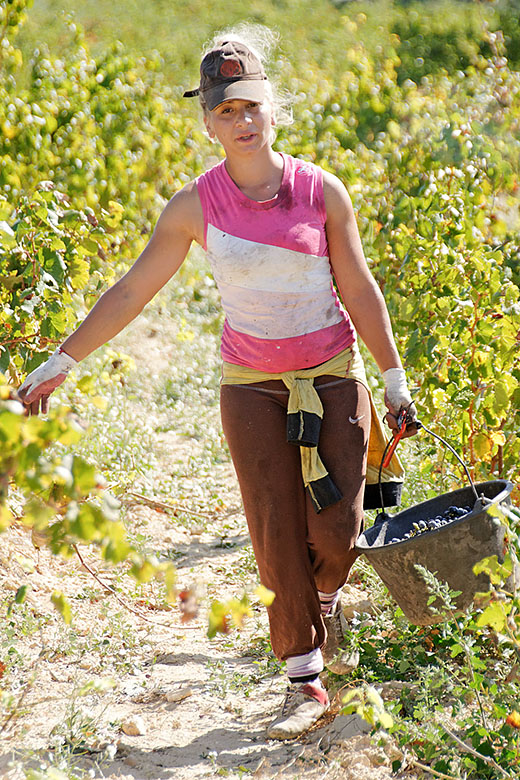
|
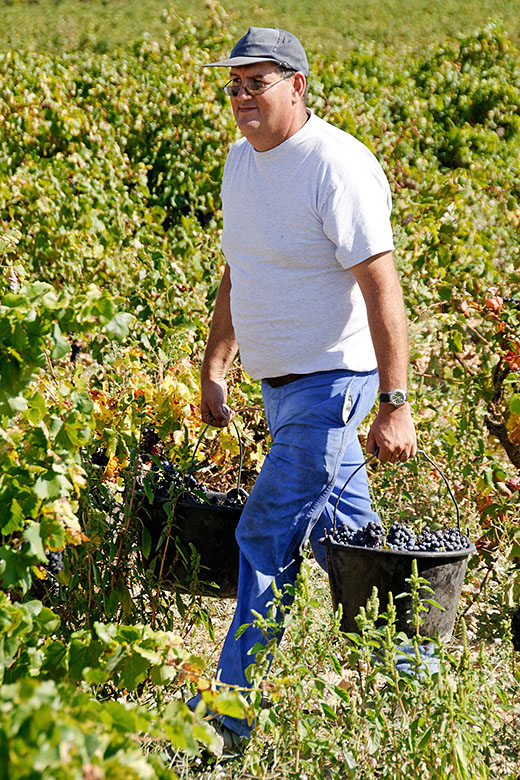
|
Some of the pickers are camera-shy... |
...some love to have their picture taken. |
Grape carrier |
When the tractor has to drive to the harvesting bin, everybody tags along. It gives the pickers a short break during which they can stretch body and legs. Of course, the people on the tractor platform can't relax: lifting the full and therefore heavy plastic containers is hard work! Once all containers have been emptied, the tractor moves back into the vineyard and the pickers resume their activity.
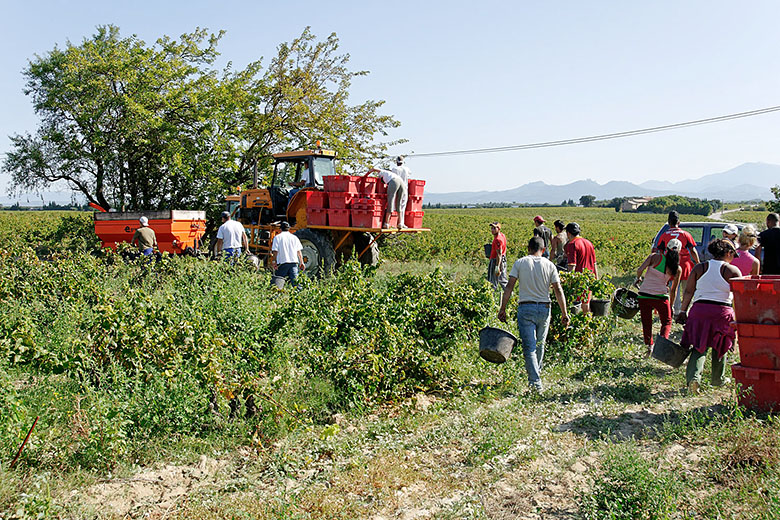
|
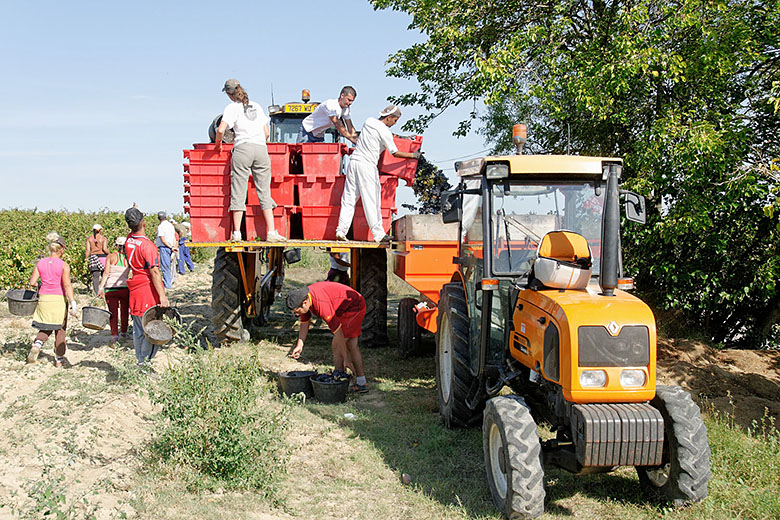
|
When there is no more space on the rear platform of the tractor... |
...grapes have to be transferred to the harvesting bin. |
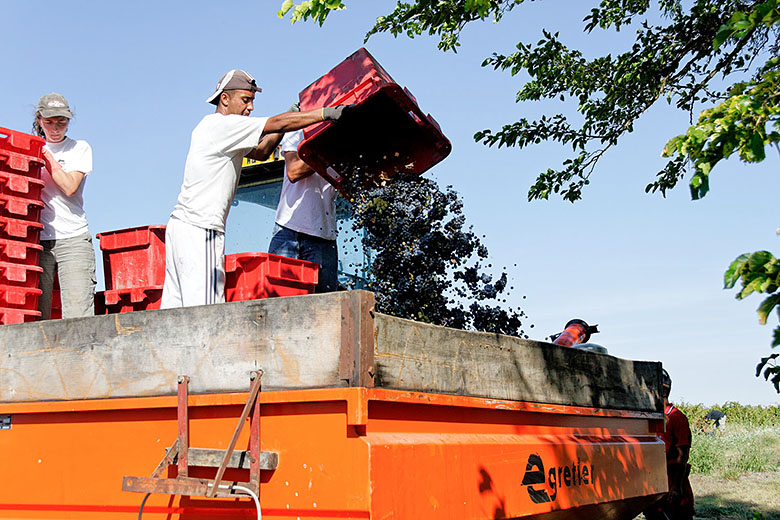
|
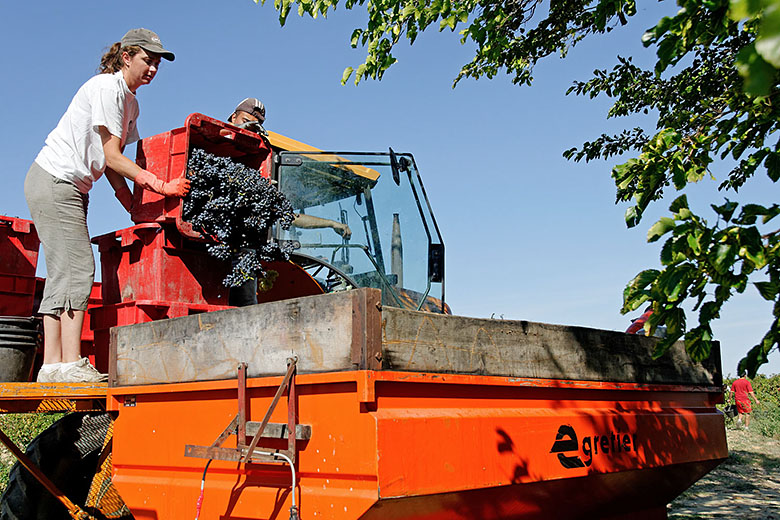
|
Like most things on the Berthet-Rayne estate... |
...this is done by hand. |
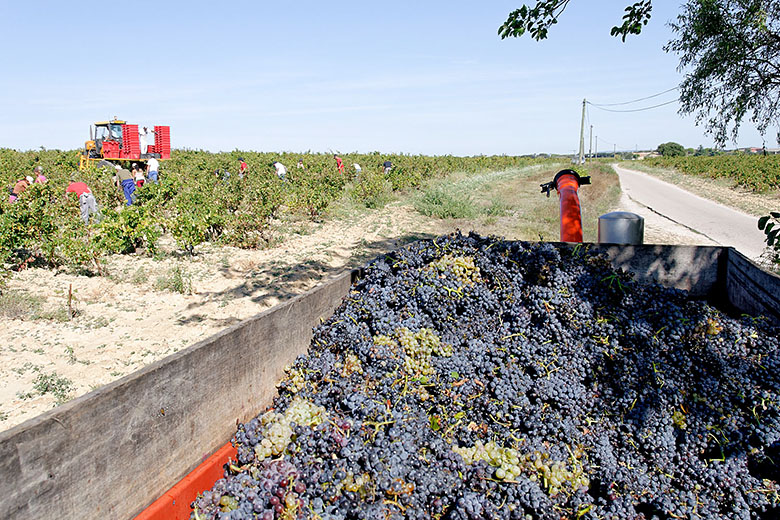
|

|
It takes many tractor trips to fill the bin! |
Taking a few seconds to pose |
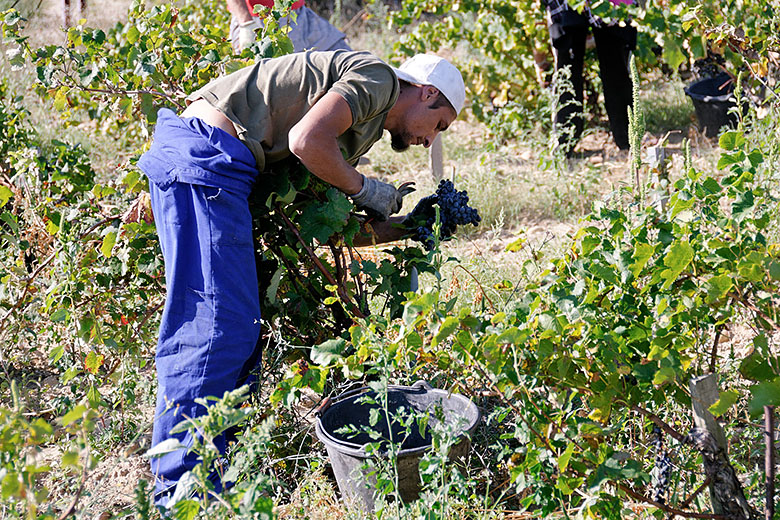
|

|
Grape picker |
Grape picker |
We went back to the winery to see what happened to all the picked grapes. A harvesting bin was backed up to the building and a hose securely connected to its pump. The other end of the hose went into a destemmer and crusher located on the top of the cement vinification tanks (see the photos taken during our first visit to get an idea of how the inside of the winery is laid out). A screw conveyor in the harvesting bin then moved the grapes to the end of the bin where they were pumped through the hose into the destemmer and crusher. The resulting liquid was emptied into one of the cement vinification tanks.
The other way grapes arrived at the destemmer and crusher was through the plastic containers on the rear tractor platform. These containers had to be lifted up and brought to the machine. This was difficult because the full bins were very heavy and because their contents had to be emptied into the destemmer and crusher carefully. Here again, everyone just went about their job efficiently; these people really made it look easy! Periodically, the alcohol level of the future wine was tested, and the temperature in the vinification vats was carefully monitored.

|
The harvesting bin is brought to the winery |

|
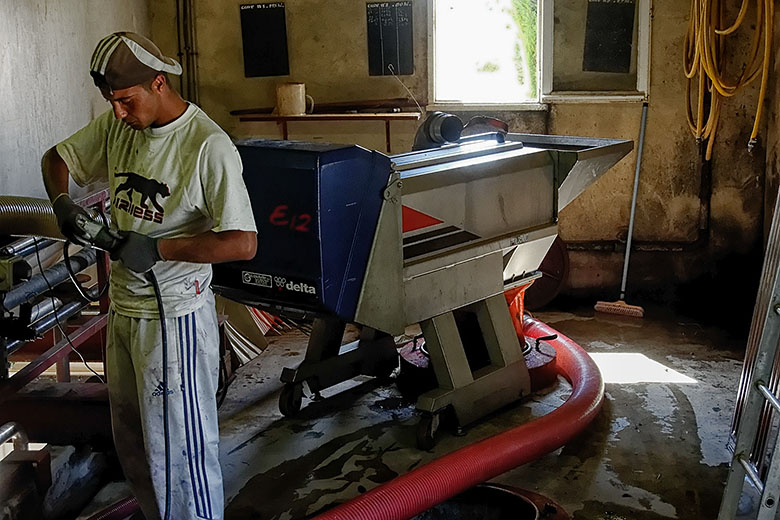
|
A hose is connected to the rear of the harvesting bin |
The other side goes to a destemmer and crusher |

|
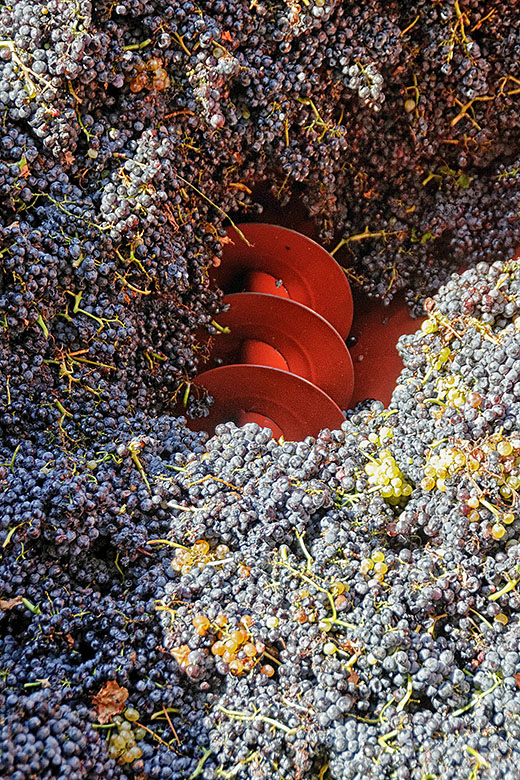
|
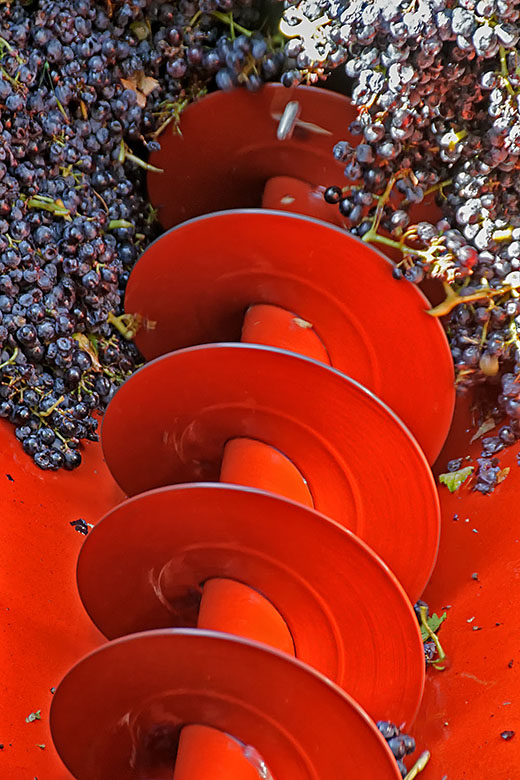
|
The rear of the harvesting bin |
A screw conveyor moves the grapes... |
...to where they are sucked into the hose. |
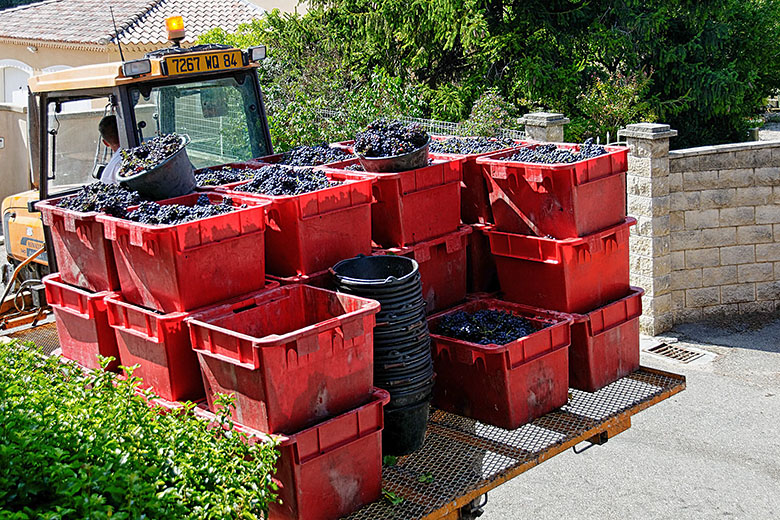
|
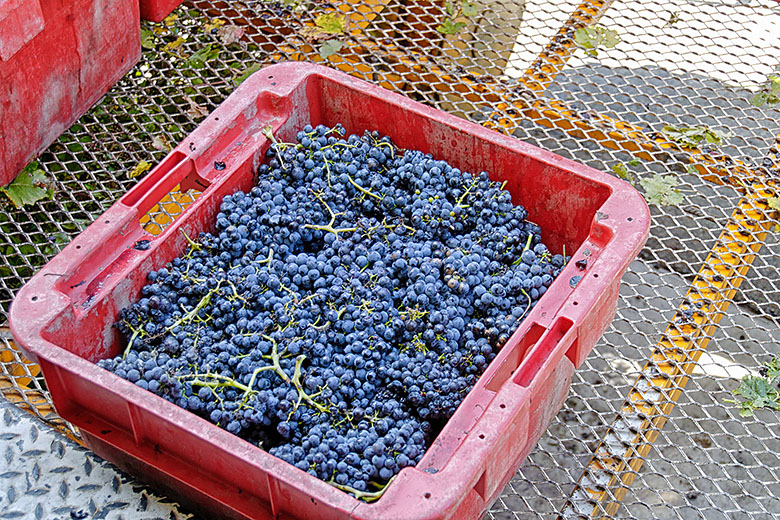
|
On the rear platform of the tractor... |
...there still are a few grape-laden containers. |

|
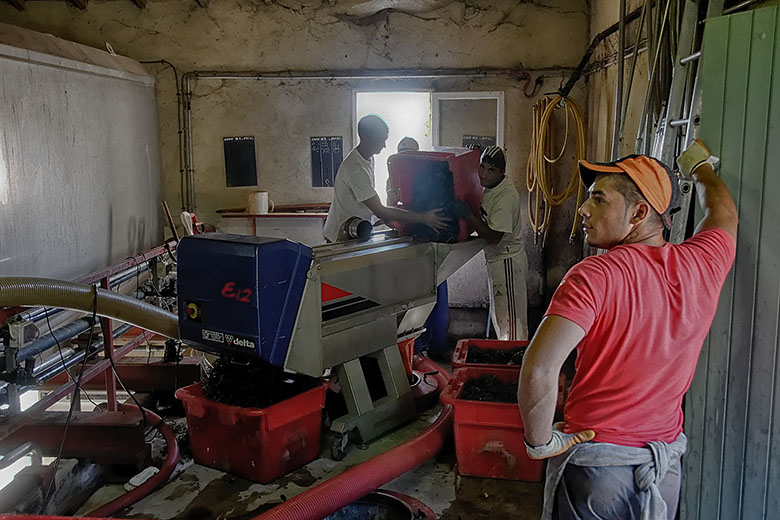
|
One by one, these have to be lifted into the winery... |
...where they are emptied into the destemmer and crusher. |
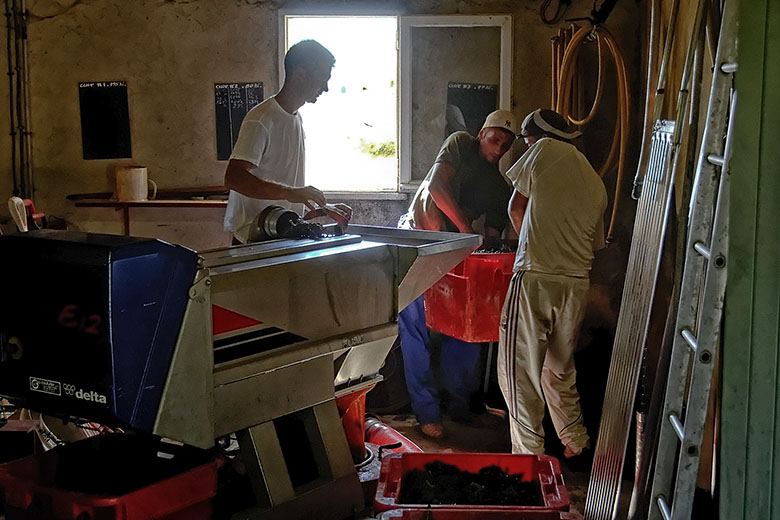
|
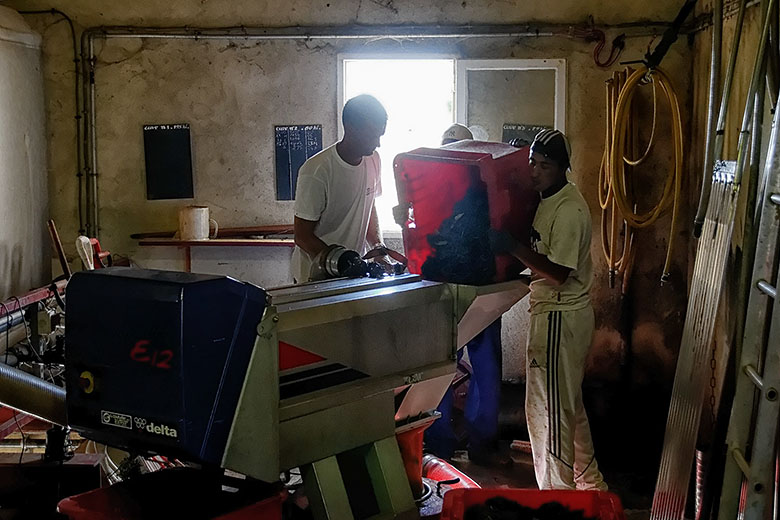
|
This is hard work... |
...because the containers are heavy... |
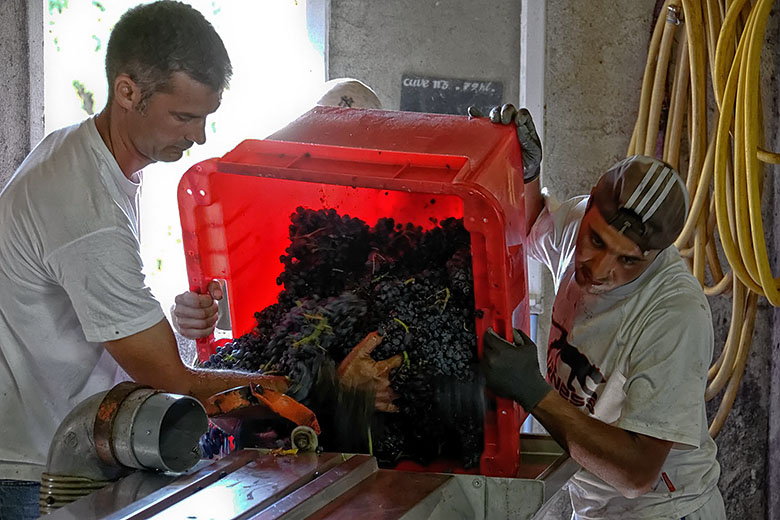
|
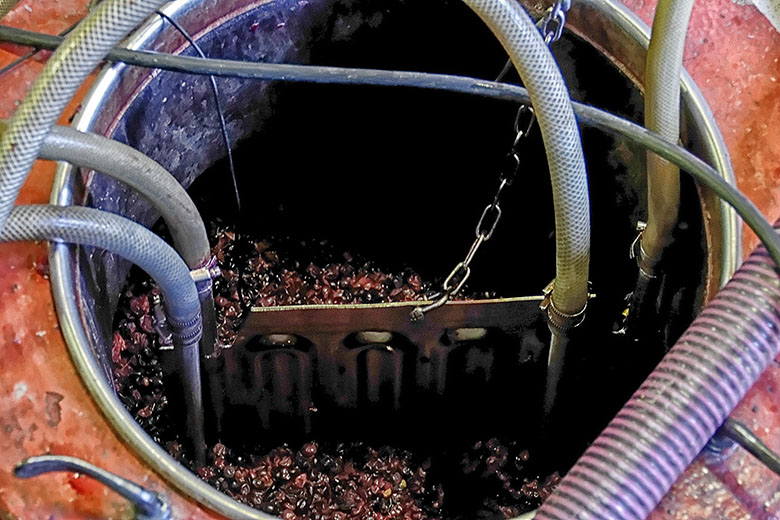
|
...and the contents have to be dropped in gently. |
The top of a full cement vinification vat |

|
Christian Berthet-Rayne checks the alcohol level of what will become a 2011 Châteauneuf-du-Pape |
At least for the time being, this concludes our reporting of the winemaking activities in the southern Rhône Valley. Our thanks go to the whole Berthet-Rayne family, Christian, Dany, Laure, and Martial, but also to all the other people who put up with our presence and are consequently depicted in these pages. I can only reiterate what I said after our first visit: the wine produced on this estate is, simply put, outstanding, and having seen where it comes from and what extraordinary care goes into its production makes it taste even better. You may well be able to enjoy some of these fine wines yourself! For instance, you could purchase a few bottles at the estate:
Domaine Berthet-Rayne
2334, route de Caderousse
84350 Courthézon
France
Phone: +33 490 70 74 14
Fax : +33 490 70 77 85
web: http://www.berthet-rayne.fr/index_gb.html
email : christian.berthet-rayne@wanadoo.fr
GPS: 44° 5.835'N, 4° 51.237'E
If a personal visit is not convenient, you can consult a list of Berthet-Rayne importers to see if it is possible to order Berthet-Rayne wine in your country. It is clearly well worth investigating, and if you manage to get a taste, we bet you'll be glad you did!
Home | Site Info | Family | The Area | Trips | France | Work | Rants | Photography | Odds & Ends
This page was last modified on July 24, 2012
Send feedback about this page to feedback@kiechle.com
https://www.kiechle.com/oddsends/brv/index.htm
(optimized for Retina display)
All contents © 1999-2026 The Kiechles